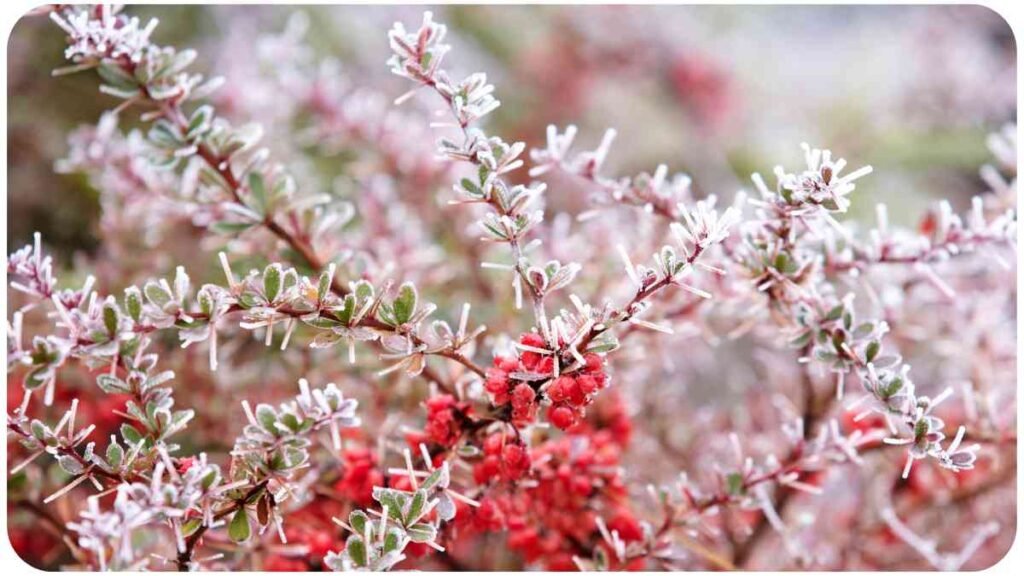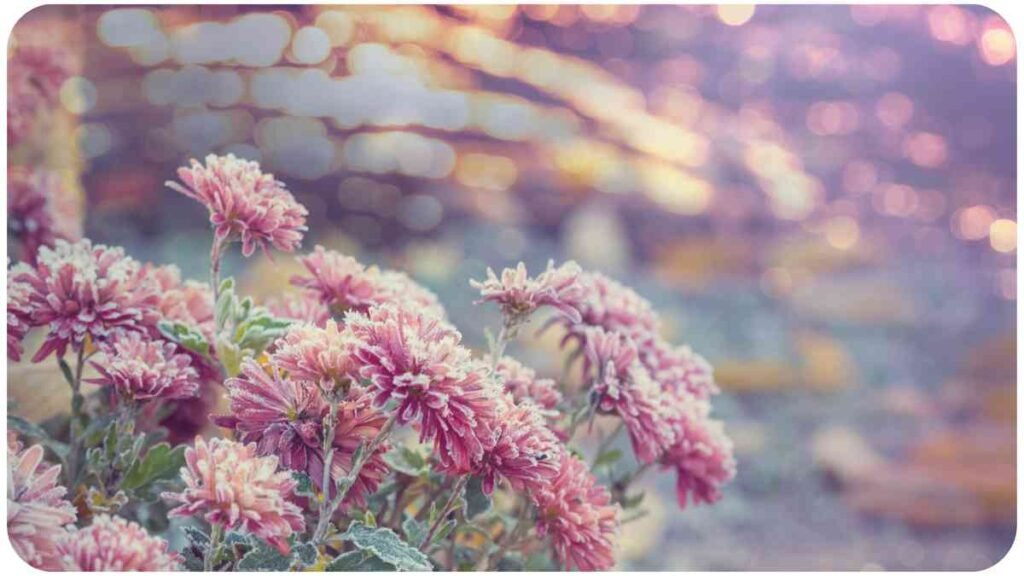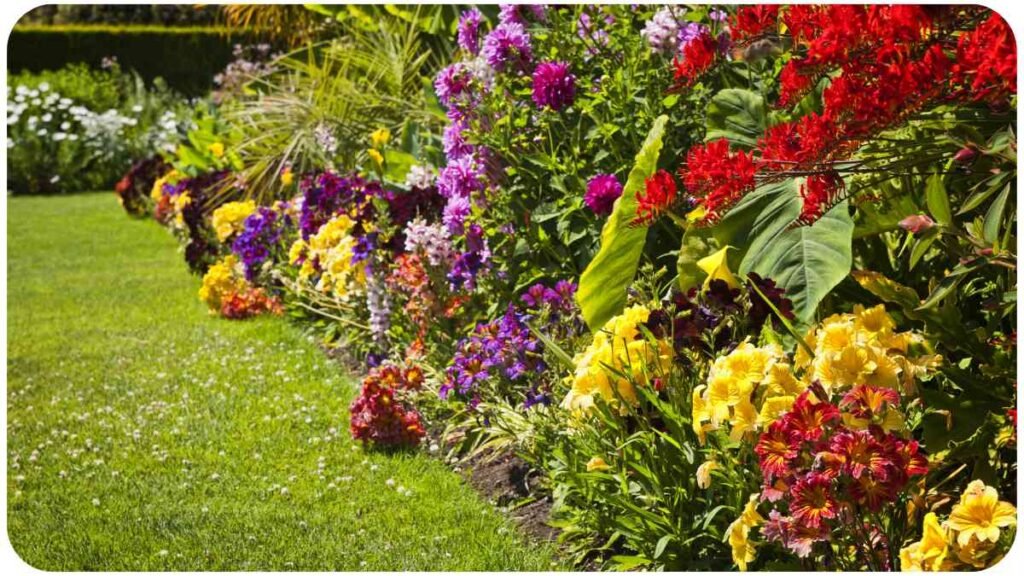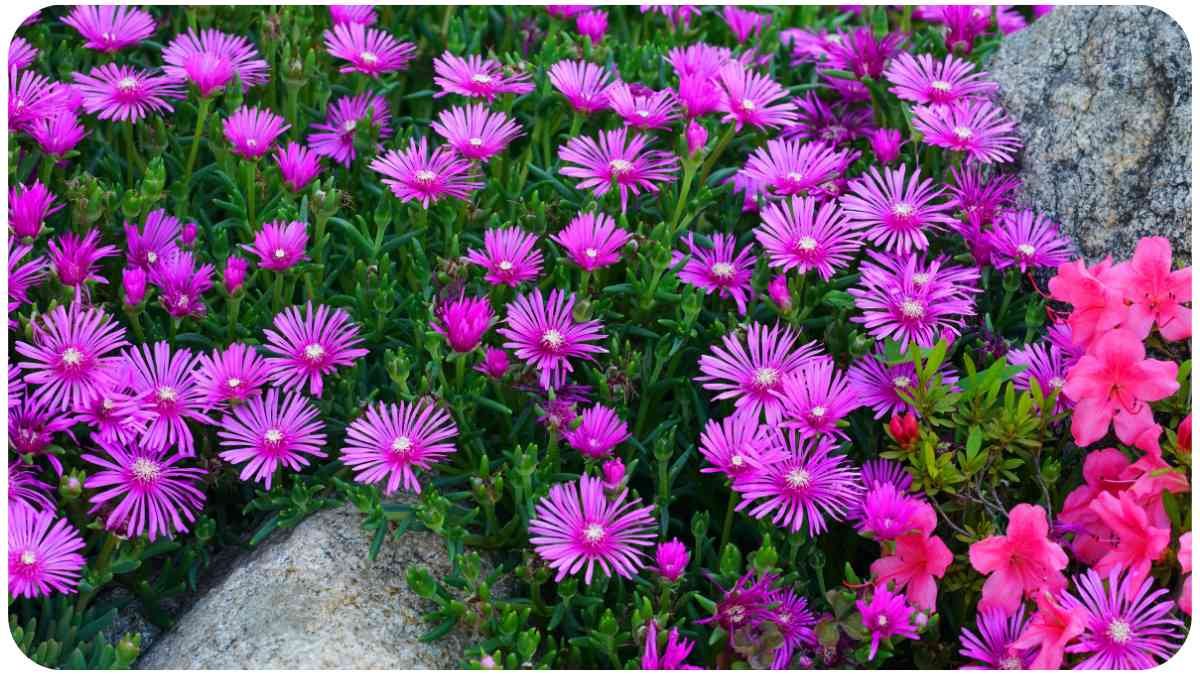Have you ever wondered why your ice plant fails to burst into the vibrant display of blooms you’ve been eagerly anticipating? Ice plants, known for their succulent leaves and stunning flowers, have captivated the hearts of gardeners worldwide.
In this comprehensive guide, we’ll delve into the intricacies of ice plant care, exploring the reasons behind the elusive blooming phenomenon.
| Takeaways |
|---|
| 1. Sunlight Matters: Ensure your ice plant gets ample sunlight for vibrant blooms. |
| 2. Soil is Crucial: Well-draining soil is essential to prevent waterlogged roots and promote blooming. |
| 3. Pruning Precision: Timing and technique matter; strategic pruning enhances blooming. |
| 4. Pest Vigilance: Address pests promptly to safeguard blooming potential. |
| 5. Diversity in Design: Complementary plants enhance aesthetics and may contribute to better blooming conditions. |
| 6. Seasonal Strategies: Adjust care routines based on seasons to optimize blooming. |
| 7. Learning from Others: Success stories offer valuable lessons; adapt strategies to fit your ice plant’s unique needs. |
2. The Basics of Ice Plant Care

Sunlight Requirements
| Sunlight Level | Blooming Impact |
|---|---|
| Full Sun | Abundant Blooms |
| Partial Sun | Moderate Blooms |
| Shade | Limited to No Blooms |
One of the key factors influencing ice plant blooming is sunlight. These sun-loving plants thrive in full sunlight, soaking in the energy needed for prolific flowering. Ensure your ice plant receives the right amount of sunlight based on its specific needs.
Discover the secrets to nurturing lush Cryptomeria that flourishes with vitality. Unearth the art of care for a garden jewel that stands out with its unique beauty and resilience.
Soil Conditions
| Soil Type | Blooming Impact |
|---|---|
| Well-Draining | Optimal Blooms |
| Sandy | Tolerable Blooms |
| Heavy Clay | Blooming Challenges |
Well-draining soil is crucial for ice plants. Their roots despise sitting in waterlogged conditions. Amend your soil for improved drainage, creating an environment conducive to successful blooming.
Watering Tips
| Watering Frequency | Blooming Impact |
|---|---|
| Moderate | Healthy Blooms |
| Infrequent | Intense Blooms |
| Excessive | Reduced or No Blooms |
Watering is a delicate dance. Too much or too little can disrupt the blooming process. Strike a balance that aligns with the natural watering needs of your ice plant.
Dive deep into the nuances of Cryptomeria Globosa Nana care. From soil conditions to pruning techniques, this comprehensive guide equips you with the knowledge needed to ensure your Cryptomeria thrives in any environment.
Fertilization Dos and Don’ts
| Fertilizer Type | Blooming Impact |
|---|---|
| Balanced | Robust Blooms |
| Nitrogen-Rich | Lush Foliage, Fewer Blooms |
| Phosphorus-Rich | Enhanced Blooms |
Fertilization plays a vital role in ice plant health. Understand the needs of your plant, and choose the right fertilizer to encourage the development of vibrant blooms.
3. Common Problems with Ice Plant Blooming

Lack of Sunlight
In the world of ice plants, sunlight is akin to lifeblood. Insufficient sunlight often leads to sparse or no blooms at all. Evaluate your garden’s sunlight exposure and consider relocating your ice plant to a sunnier spot if necessary.
Poor Soil Drainage
4. The Impact of Temperature on Blooming
Winter Challenges
| Temperature Range | Blooming Impact |
|---|---|
| Frosty Conditions | Blooming Delay or Absence |
| Mild Winters | Consistent Blooms |
Winter can pose challenges to ice plant blooming. Exposure to frosty conditions may delay or prevent blooming. Consider protective measures during colder months to ensure your ice plant’s resilience.
Uncover the mysteries behind a browning Cryptomeria. This insightful guide breaks down the nine possible causes and offers effective solutions to bring your Cryptomeria back to its vibrant, green glory.
Summer Heat and Blooming
| High Temperatures | Blooming Impact |
|---|---|
| Excessive Heat | Stress, Reduced Blooms |
| Optimal Heat | Flourishing Blooms |
While ice plants adore sunlight, excessively high temperatures can induce stress and inhibit blooming. Monitor and provide shade during extreme heat, fostering a conducive environment for blooming.
5. Pruning Practices for Healthy Blooms
When to Prune
| Pruning Timing | Blooming Impact |
|---|---|
| Early Spring | Encourages Abundant Blooms |
| After Blooming | Stimulates New Growth |
| Late Fall | Prepares for Winter Dormancy |
Strategic pruning enhances blooming. Prune early in spring to stimulate robust growth, after blooming to encourage new buds, and in late fall to prepare your ice plant for winter dormancy.
How to Prune Correctly
| Pruning Techniques | Blooming Impact |
|---|---|
| Deadheading | Prolongs Blooming Period |
| Shape Trimming | Enhances Aesthetic Appeal |
| Removal of Diseased | Prevents Spread of Diseases |
Master the art of pruning. Deadheading spent flowers prolongs the blooming period, shape trimming improves aesthetics, and removing diseased parts prevents the spread of diseases that could impede blooming.
Transform your struggling Lemon Cypress into a thriving beauty with this expert guide. Banish dryness and revive lush greenery as you follow step-by-step instructions to bring vitality back to your Lemon Cypress.
Mistakes to Avoid
| Common Pruning Mistakes | Blooming Impact |
|---|---|
| Over-pruning | Reduced Blooms, Stunted Growth |
| Incorrect Timing | Missed Blooming Opportunities |
| Neglecting Sanitization | Disease Spread, Blooming Setbacks |
Avoid common pruning pitfalls. Over-pruning can lead to reduced blooms and stunted growth. Incorrect timing may cause missed blooming opportunities. Ensure your pruning tools are sanitized to prevent the spread of diseases.
6. Pests and Diseases: Enemies of Blooming
Identifying Common Pests
| Common Pests | Signs of Infestation |
|---|---|
| Aphids | Distorted Leaves |
| Spider Mites | Webbing on Plant |
| Snails and Slugs | Chewed Leaves, Slimy Trails |
| Whiteflies | White Residue on Leaves |
Pests can wreak havoc on ice plants. Recognize the signs of common pests and take prompt action to mitigate infestations, safeguarding your plant’s blooming potential.
Effective Pest Management
| Pest Management Strategies | Blooming Impact |
|---|---|
| Natural Predators | Encourages Blooms, Maintains Balance |
| Neem Oil | Non-Toxic Pest Control |
| Companion Planting | Deters Pests, Enhances Blooming |
Implement effective pest management strategies. Encourage natural predators, use neem oil for non-toxic control, and consider companion planting to deter pests and enhance blooming.
Instill a love for gardening in your little ones with “Cultivating Green Thumbs: A Toddler’s Gardening Guide“. This delightful guide provides creative and age-appropriate activities, making gardening a joyous and educational experience for your toddlers.
Disease Prevention Strategies
| Disease Prevention Tips | Blooming Impact |
|---|---|
| Proper Air Circulation | Reduces Fungal Issues |
| Avoid Overwatering | Minimizes Root Rot Risk |
| Sanitize Pruning Tools | Prevents Disease Transmission |
Prevention is key to a healthy blooming ice plant. Ensure proper air circulation, avoid overwatering to minimize root rot risk, and regularly sanitize pruning tools to prevent disease transmission.
7. Success Stories: Blooming Triumphs
Inspiring Ice Plant Journeys
In the world of gardening, success stories serve as beacons of inspiration. Let’s delve into the journeys of passionate gardeners who transformed their struggling ice plants into blooming marvels.
Meet Emily from Portland, Oregon, who revamped her soil to achieve optimal drainage, leading to an explosion of vibrant blooms. These real-life experiences offer valuable insights and motivation for those facing similar blooming challenges.
Lessons from Successful Gardeners
Learn from the triumphs of others. Successful gardeners share common lessons that can elevate your ice plant’s blooming potential:
- Adapt to Sunlight Needs: Understand your ice plant’s specific sunlight requirements and adjust its location accordingly. Many success stories attribute blooming breakthroughs to strategic positioning under ample sunlight.
- Customize Soil Conditions: Soil modification is a game-changer. Tailor your soil to meet the well-draining preferences of ice plants. Success often lies in finding the right soil balance.
- Prune with Precision: Timing and technique matter when it comes to pruning. Successful gardeners emphasize the significance of well-timed and correctly executed pruning practices for promoting blooming.
- Integrated Pest Management: Pest control is an ongoing battle, but it’s conquerable. Integrate natural predators, like ladybugs, and explore organic solutions such as neem oil for effective and non-toxic pest management.
8. Troubleshooting Guide
Quick Fixes for Non-Blooming Scenarios
Encountering a blooming standstill? Here are quick fixes to jumpstart the blooming process:
- Evaluate Sunlight Exposure: Ensure your ice plant receives adequate sunlight. Consider moving it to a sunnier spot if needed.
- Check Soil Drainage: Assess the soil for drainage issues. Amend it with sand or perlite to enhance drainage and create a blooming-friendly environment.
- Adjust Watering Habits: Strike a balance in watering. Too much or too little can disrupt blooming. Adjust based on your plant’s needs.
- Review Pruning Practices: Confirm you’re pruning at the right times and using proper techniques. Avoid over-pruning, which can hinder blooming.
Seeking Professional Help
If troubleshooting doesn’t yield results, consider seeking advice from gardening experts or local horticulturists. Professional insight can uncover specific issues and provide tailored solutions for your ice plant’s blooming woes.
9. Ice Plant Varieties for Blooming Enthusiasts

Top Blooming Varieties
| Ice Plant Variety | Blooming Characteristics |
|---|---|
| Delosperma Cooperi | Profuse Pink to Purple Blooms |
| Delosperma Nubigenum | Yellow Flowers, Cold Tolerant |
| Aptenia Cordifolia | Reddish-Purple Blooms, Trailing |
Selecting the right ice plant variety is pivotal for blooming success. Explore these top varieties known for their stunning blooms and unique characteristics.
Choosing the Right One for Your Garden
Consider your climate, soil conditions, and aesthetic preferences when choosing an ice plant variety. Consult local nurseries or gardening experts for personalized recommendations based on your specific blooming goals.
10. Seasonal Blooming Guide
Blooming in Spring
Spring is a season of renewal, and your ice plant can join the celebration with a burst of colorful blooms. As temperatures rise and daylight increases, your plant awakens from winter dormancy. Ensure it receives ample sunlight, provide balanced fertilization, and witness the magical transformation as blooms grace your garden.
Summer Spectacles
Summer is the prime time for many ice plant varieties to showcase their vibrant hues. Embrace the warmth of the season by maintaining optimal watering and keeping an eye on temperature extremes. This is also the season for strategic pruning to encourage continuous blooming and shape your ice plant for an attractive display.
Fall Florals
While some ice plants may wind down their blooming in fall, others continue to add flair to your garden. As temperatures cool, consider adjusting your watering routine to prevent overwatering and promote a healthy transition into winter dormancy. Fall blooms contribute to a colorful and lively garden even as the season changes.
11. Garden Aesthetics: Combining Ice Plants with Other Flora
Complementary Planting Ideas
| Companion Plants | Blooming Enhancement |
|---|---|
| Sedum | Drought-Tolerant, Texture Variety |
| Lavender | Fragrance, Color Harmony |
| Echeveria | Succulent Companionship |
Create a visually stunning garden by combining ice plants with complementary flora. Explore these companion plants to enhance blooming and add diversity to your garden landscape.
Designing a Blooming Paradise
When planning your garden, consider the following design tips:
- Color Harmony: Select plants with colors that complement your ice plant’s blooms, creating a harmonious visual palette.
- Texture Variety: Integrate plants with different textures to add depth and visual interest to your garden.
- Height Consideration: Arrange plants with varying heights to create a dynamic and layered garden aesthetic.
12. Q&A Session: Readers’ Blooming Concerns
Addressing Common Questions
Readers often share similar concerns about ice plant blooming. Let’s address some common questions:
- Why is my ice plant not blooming?
- Possible causes include insufficient sunlight, poor soil drainage, overwatering, or nutrient deficiencies.
- How can I enhance blooming in my ice plant?
- Focus on providing adequate sunlight, well-draining soil, balanced watering, and appropriate pruning practices.
- Are there specific pests that affect blooming?
- Aphids, spider mites, and snails can hinder blooming. Implement pest control measures to address infestations promptly.
Expert Advice
Renowned horticulturist Dr. Jasmine Green shares her insights:
“Successful ice plant blooming requires a holistic approach. From sunlight and soil to pruning and pest management, each factor plays a crucial role. Observing your plant’s behavior and making adjustments accordingly will pave the way for a flourishing garden.”
13. The Journey to Blooming Bliss
Celebrating Successes
Embarking on the journey to ice plant blooming is a fulfilling endeavor. Celebrate each bloom as a testament to your care and dedication. Share your success stories with fellow gardeners, inspiring a community of blooming enthusiasts.
Embracing Challenges
Challenges are inherent in gardening, and the road to blooming bliss may have its bumps. Don’t be disheartened by setbacks; instead, view them as opportunities to learn and refine your approach. Each challenge overcome brings you closer to unlocking the full blooming potential of your ice plant.
14. Conclusion
Final Thoughts on Ice Plant Blooming
In unraveling the mystery of why your ice plant may not be blooming, we’ve explored a comprehensive guide to care, troubleshooting, and design. By understanding the nuances of sunlight, soil, watering, and pruning, you’re equipped to navigate potential pitfalls and foster a thriving garden full of vibrant blooms.
Remember, the journey to blooming bliss is not a one-size-fits-all endeavor. Embrace experimentation, learn from both successes and challenges, and tailor your approach to the unique needs of your ice plant.
As you embark on this horticultural adventure, may your garden become a canvas of colors, showcasing the beauty of ice plant blooms in all their glory.
Happy gardening, and may your ice plants bloom abundantly!
Further Reading
Greg App: Ice Plant Flowers Guide:
- Explore this comprehensive guide on ice plant flowers, diving into specific varieties, care tips, and blooming strategies. A valuable resource for enthusiasts seeking detailed insights into ice plant cultivation.
Garden Tabs: Ice Plant Not Blooming – Why and What to Do:
- Discover reasons behind your ice plant’s reluctance to bloom and practical solutions. This article from Garden Tabs provides troubleshooting advice and actionable steps to promote blooming.
Sunday Gardener: How to Get Ice Plant Bloom:
- Sunday Gardener offers a step-by-step guide on fostering ice plant blooms. Learn expert tips on soil, sunlight, and maintenance practices to maximize the blooming potential of your ice plant.
FAQs
Why is my ice plant not blooming?
Insufficient sunlight, poor soil drainage, overwatering, and nutrient deficiencies are common reasons for a lack of blooming in ice plants.
How can I enhance blooming in my ice plant?
Focus on providing adequate sunlight, well-draining soil, balanced watering, and appropriate pruning practices to encourage blooming.
Are there specific pests that affect blooming?
Aphids, spider mites, and snails can hinder blooming. Implement pest control measures to address infestations promptly.
When is the best time to prune my ice plant for optimal blooming?
Prune your ice plant in early spring to stimulate growth, after blooming to encourage new buds, and in late fall to prepare for winter dormancy.
Can I plant other flowers alongside my ice plant to enhance blooming?
Yes, companion planting with species like Sedum, Lavender, and Echeveria can complement ice plants, creating a visually appealing garden and potentially enhancing blooming conditions.

Hellen James, a seasoned author at Unified Publishers LLC, brings a wealth of expertise to diverse niches. Specializing in pet care, outdoor adventures, lifestyle, wellness, and culinary delights, Hellen crafts insightful and engaging content that unlocks the full potential of readers’ interests. Explore, learn, and thrive with Hellen James.

